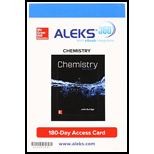
Concept explainers
Interpretation:
The balanced
Concept introduction:
In a balanced radioactive decay
And
In the balanced radioactive decay, the subscript present on the individual particles represents the
While writing the abbreviated form of any radioactive reaction, the reactant is written first followed by parenthesis, which contains the bombarded particle first and then the emitted particle. After this the product is written.
Answer to Problem 38QP
Solution:
(a)
(b)
(c)
Explanation of Solution
a)
It is known that while writing the abbreviated form, the reactant is written first.
Here, the reactant is
Then, it is followed by the parentheses where the bombarded particle is written first, followed by the emitted particles. These are separated by commas.
Here, the bombarded particle is
At the end, the parenthesis is closed and the product is written.
Here, the product is
Thus, the equation can be written as
Now, apply the balancing rules as
And
On the left side of the reaction, the sum of the atomic numbers is given by the expression as follows:
On the right-hand side of the reaction, the sum of the atomic numbers is calculated as follows:
Thus, the atomic number of X is calculated as follows:
Similarly,
On the left side of the reaction, the sum of the mass numbers is given by the expression as follows:
On the right-hand side of the reaction, the sum of the mass numbers is as follows:
Thus, the mass number of X is calculated as follows:
So, X will be
Hence, the balanced reaction is given as follows:
b)
It is known that while writing the abbreviated form, the reactant is written first.
Here, the reactant is
Then, it is followed by the parenthesis where the bombarded particle is written first followed by the emitted particles. These are separated by commas.
Here, the bombarded particle is
At the end, the parenthesis is closed and the product is written.
Here, the product is
Thus, the equation can be written as follows:
Now, apply the balancing rules as follows:
And
On the left side of the reaction, the sum of the atomic numbers is given as follows:
On the right hand side of the reaction, the sum of the atomic numbers is
Thus, the atomic number of X is calculated as follows:
Similarly,
On the left side of the reaction, the sum of the mass numbers is calculated as follows:
On the right hand side of the reaction, the sum of the mass numbers is
Thus, the mass number of X is calculated as follows:
So, X will be
Hence, the balanced reaction is given as follows:
c)
It is known that while writing the abbreviated form, the reactant is written first.
Here, the reactant is
Then, it is followed by the parenthesis where the bombarded particle is written first followed by the emitted particles. These are separated by commas.
Here, the bombarded particle is
At the end, the parenthesis is closed and the product is written.
Here, the product is
Thus, the equation can be written as follows:
Now, apply the balancing rules as follows:
And
On the left side of the reaction, the sum of the atomic numbers is given as follows:
On the right hand side of the reaction, the sum of the atomic numbers is
Thus, the atomic number of X is calculated as follows:
Similarly,
On the left side of the reaction, the sum of the mass numbers is calculated as follows:
On the right hand side of the reaction, the sum of the mass numbers is
Thus, the mass number of X is calculated as follows:
So, X will be
Hence, the balanced reaction is given as follows:
Want to see more full solutions like this?
Chapter 20 Solutions
ALEKS 360-ACCESS (1 SEMESTER)
- Write the balanced nuclear equation for the production of the following transuranium elements: (a) berkelium-244, made by the reaction of Am-241 and He-4. (b) fermiurn-254, made by the reaction of Pu-239 with a large number of neutrons. (c) lawrencium-257, made by the reaction of Cf-250 and B-11. (d) dubnium-260, made by the reaction of Cf-249 and N-15arrow_forwardWrite a balanced equation for each of the following nuclear reactions: (a) the production of 17O from 14N by a particle bombardment. (b) the production of 14C from 14N by neutron bombardment. (c) the production of 233Th from 232Th by neutron bombardment. (d) the production of 239U from 238U by H12 bombardmentarrow_forwardA sample of rock was found to contain 8.23 mg of rubidium-87 and 0.47 mg of strontium-87.. (a) Calculate the age of the rock if the half-life of the decay of rubidium by emission is 4.71010 y. (b) If some S3887r was initially present in the rock, would the rock be younger, older, or the same age as the age calculated in (a)? Explain your answer.arrow_forward
 General Chemistry - Standalone book (MindTap Cour...ChemistryISBN:9781305580343Author:Steven D. Gammon, Ebbing, Darrell Ebbing, Steven D., Darrell; Gammon, Darrell Ebbing; Steven D. Gammon, Darrell D.; Gammon, Ebbing; Steven D. Gammon; DarrellPublisher:Cengage Learning
General Chemistry - Standalone book (MindTap Cour...ChemistryISBN:9781305580343Author:Steven D. Gammon, Ebbing, Darrell Ebbing, Steven D., Darrell; Gammon, Darrell Ebbing; Steven D. Gammon, Darrell D.; Gammon, Ebbing; Steven D. Gammon; DarrellPublisher:Cengage Learning Chemistry by OpenStax (2015-05-04)ChemistryISBN:9781938168390Author:Klaus Theopold, Richard H Langley, Paul Flowers, William R. Robinson, Mark BlaserPublisher:OpenStax
Chemistry by OpenStax (2015-05-04)ChemistryISBN:9781938168390Author:Klaus Theopold, Richard H Langley, Paul Flowers, William R. Robinson, Mark BlaserPublisher:OpenStax General, Organic, and Biological ChemistryChemistryISBN:9781285853918Author:H. Stephen StokerPublisher:Cengage Learning
General, Organic, and Biological ChemistryChemistryISBN:9781285853918Author:H. Stephen StokerPublisher:Cengage Learning Chemistry & Chemical ReactivityChemistryISBN:9781133949640Author:John C. Kotz, Paul M. Treichel, John Townsend, David TreichelPublisher:Cengage Learning
Chemistry & Chemical ReactivityChemistryISBN:9781133949640Author:John C. Kotz, Paul M. Treichel, John Townsend, David TreichelPublisher:Cengage Learning Chemistry & Chemical ReactivityChemistryISBN:9781337399074Author:John C. Kotz, Paul M. Treichel, John Townsend, David TreichelPublisher:Cengage Learning
Chemistry & Chemical ReactivityChemistryISBN:9781337399074Author:John C. Kotz, Paul M. Treichel, John Townsend, David TreichelPublisher:Cengage Learning Chemistry: The Molecular ScienceChemistryISBN:9781285199047Author:John W. Moore, Conrad L. StanitskiPublisher:Cengage Learning
Chemistry: The Molecular ScienceChemistryISBN:9781285199047Author:John W. Moore, Conrad L. StanitskiPublisher:Cengage Learning





